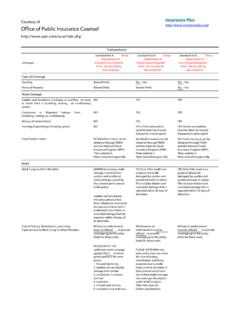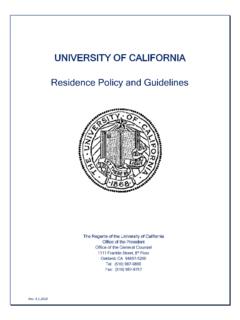Transcription of Internal Revenue Service memorandum
1 Office of Chief Counsel Internal Revenue Service memorandum Number: 201549024. Release Date: 12/4/2015. CC:ITA:B07: CJMagee POSTN-124481-15. UILC: date: October 23, 2015. to: Associate Area Counsel - Houston (Group 2). Large Business & International Natural Resources and Construction (CC:LB&I:NR:PNX). Attn: Katelynn M. Winkler from: Kathleen Reed Chief, Branch 7. Office of Associate Chief Counsel (Income Tax & Accounting). (CC:ITA:7). subject: Capitalization of Software Development Costs POSTN-124481-15. This Chief Counsel Advice responds to your request for assistance. This advice may not be used or cited as precedent. ISSUE. Whether the principles and conclusions of PLR 200236028 continue to apply to the treatment of acquired and developed software costs? CONCLUSION. The principles and conclusions of PLR 200236028 continue to apply to the treatment of acquired and developed software costs.
2 FACTS. In PLR 200236028 (June 4, 2002), the Internal Revenue Service addressed the income tax consequences on the purchase, development, and implementation of POSTN-124481-15 2. Enterprise Resource Planning (ERP) software acquired by a taxpayer from a third party as well as acquired computer hardware. ERP software is a database software system that integrates different business functions such as financial accounting, sales and distribution, materials management, and production planning. Implementation of the ERP system generally involves various categories of costs, including (1) costs to acquire the ERP software package from the vendor, (2) costs to install the acquired ERP software on the taxpayer's computer hardware and to configure the software to the taxpayer's needs through the use of options and templates embedded in the software, (3) software development costs, and (4) costs to train employees in the use of the new software.
3 The ERP software is not usable until the implementation is completed. The Service concluded the following: (1) The cost of the purchased ERP software (including the sales tax) is to be capitalized under 263(a) of the Internal Revenue Code and amortized under 167(f). ratably over 36 months, beginning with the month the software is placed in Service by the taxpayer;. (2) The employee training and related costs (maintenance, troubleshooting, and running reports during the training; such costs did not include any reorganizational expenditures) are deductible as current expenses under 162. However, the pre-paid training expenses are deductible as a current expense in the year in which incurred under the requirements of 461;. (3) The separately stated computer hardware cost is to be capitalized under 263(a) and depreciated under 168 over a 5-year recovery period.
4 (4) If the taxpayer is solely responsible for the creation and performance of the software project covered by the consulting contracts, the costs of writing machine readable code software (and its allocable portion of the costs of modeling and design of additional software) under the taxpayer's consulting contracts are self-developed computer software and are allowed to be deductible as current expenses pursuant to section (1) of Rev. Proc. 2000-50, 2000-2 601; and (5) The costs of option selection and implementation of templates (and its allocable portion of the costs of modeling and design of additional software) under the taxpayer's consulting contracts are installation/modification costs that are to be capitalized and amortized as part of the purchased ERP software ratably over 36.
5 Months, beginning with the later of the month the purchased software is placed in Service by the taxpayer or the month the template work is available for use by the taxpayer. The undefined miscellaneous costs under the taxpayer's consulting contracts are also capitalized as a part of the underlying purchased ERP software and amortized over the same 36 month period described in the preceding sentence. On December 19, 2002, the Service and Treasury Department issued proposed regulations that explained how 263(a) applies to amounts paid to acquire, create, or POSTN-124481-15 3. enhance intangible assets (the proposed intangible regulations ). 67 Fed. Reg. 77701. The proposed intangible regulations did not specifically address the treatment of ERP. implementation costs. Instead, the preamble to the proposed intangible regulations provided that the Service and Treasury Department expected that the final regulations would address these costs and, subject to the simplifying conventions provided in the proposed intangible regulations for employee compensation, overhead, and de minimis transaction costs, will treat such costs in a manner consistent with the treatment prescribed in PLR 200236028.
6 On January 5, 2004, the Service and Treasury Department issued final regulations that explained how 263(a) applies to amounts paid to acquire, create, or enhance intangible assets (the final intangible regulations ). 9107, 69 Fed. Reg. 436. The final intangible regulations also did not specifically address the treatment of ERP implementation costs. The preamble to the final intangible regulations stated that issues relating to the development and implementation of computer software were more appropriately addressed in separate guidance, and not in the final intangible regulations. The preamble further provided that, while the final intangible regulations require a taxpayer to capitalize an amount paid to another party to acquire computer software from that party in a purchase or similar transaction (see (a)-4(c) of the Income Tax Regulations), nothing in the final intangible regulations was intended to affect the determination of whether computer software is acquired from another party in a purchase or similar transaction, or whether computer software is developed or otherwise self-created (including amounts paid to implement ERP software).
7 The preamble indicated that the issue of the treatment of ERP implementation costs was more appropriately addressed in separate guidance dedicated exclusively to computer software issues and, until such separate guidance was issued, that taxpayers may continue to rely on Rev. Proc. 2000-50. The preamble to the final intangible regulations did not cite to PLR 200236028. To date, no separate guidance has been issued. LAW AND ANALYSIS. Some taxpayers are taking the position that the conclusions set forth in PLR. 200236028 no longer apply following the promulgation of (a)-4. We disagree. Section 162(a) provides, in part, that there shall be allowed as a deduction all the ordinary and necessary expenses paid or incurred during the taxable year in carrying on any trade or business.
8 However, section 263(a) provides, in part, that no deduction shall be allowed for any amount paid out for new buildings or for permanent improvements or betterments made to increase the value of any property or estate. Section (a)-4 provides rules for requiring the capitalization of costs associated with the acquisition or creation of an intangible asset. POSTN-124481-15 4. Section (a)-4(c)(1) requires a taxpayer to capitalize amounts paid to another party to acquire any intangible from that party in a purchase or similar transaction. Section (a)-4(c)(1) also provides a nonexclusive list of examples of the types of intangibles taxpayers must capitalize including, in relevant part, computer software. Section (a)-4(c)(1)(xiv). Section (a)-4 did not render PLR 200236028 obsolete.
9 The cost of the purchased ERP software (including the sales tax) are capital expenditures pursuant to 263(a) and (a)-4(c)(1)(xiv). Because the ERP software is not usable to the taxpayer without the option selection and implementation of templates, the costs of option selection and implementation of templates (and its allocable portion of the costs of modeling and design of additional software) are capitalized as part of the purchased ERP software. See (a)-4(g)(1). Some taxpayers are taking the position that Rev. Proc. 2000-50 allows the deduction of all software costs. We disagree. Rev. Proc. 2000-50 provides guidelines on the treatment of the costs of computer software. Section 2 of Rev. Proc. 2000-50 defines the term computer software as any program or routine (that is, any sequence of machine readable code) that is designed to cause a computer to perform a desired function or set of functions, and the documentation required to describe and maintain that program or routine.
10 Section of Rev. Proc. 2000-50 provides, in part, that the cost of developing computer software in many respects so closely resemble the kind of research and experimental expenditures that fall within the purview of 174 as to warrant similar accounting treatment. Accordingly, the Service will not disturb a taxpayer's treatment of costs paid or incurred in developing software for any particular project where all of the costs properly attributable to the development of software by the taxpayer are consistently treated as current expenses and deducted in full in accordance with rules similar to those applicable under 174. Section (2) of Rev. Proc. 2000-50 provides that with respect to the costs of acquired computer software, the Service will not disturb the taxpayer's treatment of costs that are separately stated if the costs are consistently treated as capital expenditures for an intangible asset the cost of which is to be recovered by amortization deductions ratably over a period of 36 months beginning with the month the software is placed in Service , in accordance with the rules under 167(f)(1).

















